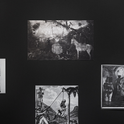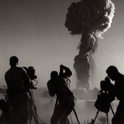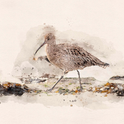During a recent week in Florence I made about a dozen visits to an exhibition at the Palazzo Strozzi. “The Russian avant-garde, Siberia and the East” makes a case for the influence of shamanistic cult objects on Kandinsky, Goncharova and other 20th century Russian artists. The reason I went so many times, however, was simply that I wanted, again and again, to look at seven paintings by Pavel Filonov (1883-1941), whom I—and many Russians—consider the most remarkable of all the many great Russian artists of the last century.
Many of Filonov’s paintings are huge and extraordinarily detailed. Seen closely, every element of Filonov’s works takes on a life of its own. One square centimetre of canvas could, if enlarged 50 or 100 times, be an entire Paul Klee—or a Miro, or a Kandinsky. Another square centimetre is more roughly textured—like the wrong side of a piece of richly coloured embroidery. Another square centimetre may be relatively empty—not a pattern but a delicate wash of colour. Each time one steps back from observing the detail of Filonov’s paintings, the work as a whole has changed. Living Head is full of joyful colour. But if you look at the painting as a whole, what you first see are the outlines of a rather mournful face.
Filonov was born to a poor family in 1883, and both of his parents died before he was 14. In 1897 his eldest sister married a prosperous engineer and the family moved from Moscow to St Petersburg. Dismayed by their new bourgeois comfort, Filonov slept on the floor, working meanwhile as a house painter. Determined to be an artist, he failed the entrance exams for the Academy of Arts three times. On his fourth attempt, he was accepted because of his exceptional knowledge of anatomy. Soon he was thrown out—for not listening to his teachers, refusing to bow to an important princess who was a patron of the Academy and “corrupting his fellow students with his works.” He was reinstated but then left of his own free will. From 1910, together with such figures as Kazimir Malevich and Vladimir Mayakovsky, he regularly took part in projects and exhibitions linked to the avant-garde.
Filonov appears to have seen the Revolution as the realisation of a dream of world harmony. Even later in life, he was reluctant to relinquish this belief. Some of his paintings bear grandiose and optimistic titles, such as Formula of the Period 1904—July 1922. Universal Shift in the Flowering of the World via the Russian Revolution. Often, however, there is a contrast between the paintings’ titles and their more melancholy mood.
Filonov was single-minded and intransigent. He worked 18-hour days and often lived just on tea, bread and potatoes. Throughout his life he inspired devotion, but he repeatedly sabotaged attempts to help him. Offered a professorship at the Academy in 1919, he refused to accept it unless all courses at the Academy were taught according to his own methods. The director, of course, did not agree to this.
The rather misleading name that Filonov gave to his method was “Analytic Art.” Believing that a painting should grow in the same sort of way as any other form of life, Filonov would start in one corner of the canvas and steadily work his way up and across to the opposite corner. Opposed to all pre-determined schemes, he believed that every painting should follow its own laws. As early as 1912 Filonov attacked Picasso—not for being outrageously innovative, but for creating a new academicism. “Cubism,” he wrote, “has reached a dead-end because of its mechanistic fundamentals.” After quoting these words, the artist Marina Koldobskaya goes on to describe Filonov’s own paintings as “pulsating and breathing crystals, knots and nets flowing into each other before the eyes of the onlookers.” Filonov’s work is indeed anything but mechanistic—even when, as in his paintings relating to the First World War (in which he fought on the Romanian Front), he is representing deathly and mechanistic forces.
A concept of great importance to Filonov was that of “madeness.” A painting was “made”—i.e. completed—when not another drop of colour could be added to it. As if adding drop after drop to an already full bowl of water, Filonov would go on adding detail until he reached that point. Remarkably, he seems never to have gone too far. For all their microscopic detail, his paintings never seem too busy or manic. They are held together by some “surface tension”; they retain their balance and unity. Van Gogh once claimed to have painted at least some pictures “that would retain their calm even in the catastrophe.” Filonov could have said the same.
In 1929 the authorities proposed a one-man exhibition of Filonov’s work. The paintings were hung, a catalogue was prepared—and then, for 18 months, the paintings remained on the walls of the Russian Museum while the authorities argued about whether or not to open the exhibition. On one occasion Filonov’s opponents brought in a group of factory workers, expecting them to declare Filonov’s work incomprehensible. The workers, however, proved unexpectedly enthusiastic. One said that Filonov was “a real treasure house.” Another commented, “Someone who took part in the war against Germany would understand.” In the end, however, the paintings were taken down.
It is difficult to talk about Filonov and his place—or lack of a place—in art history without also talking about Kazimir Malevich. The two artists moved in the same circles and collaborated on some important projects but they were opposites in almost every respect. Malevich’s name for the movement he founded around 1913 was “Suprematism” and his aspiration was always to rise above the material and the terrestrial; he was influenced by Konstantin Tsiolkovsky, a scientist, philosopher and pioneer of Russian space rocketry. Malevich is famous, above all, for his Black Square, a painting generally seen as the icon of the Russian avant-garde; the interest of this simple black quadrilateral is, of course, conceptual rather than painterly. Malevich subtitled his Red Square “painterly realism of a Russian peasant woman,” but here again we are in the realm not of story or image but of concept. Filonov is more truly a painter; he wrote of the need “to introduce the colour into each atom persistently and accurately… so that it is linked organically with the form, just as in nature a flower’s cellulose is linked with its colour.”
I sensed these contrasts most acutely at a Filonov exhibition in St Petersburg in 2006. The way out of the exhibition led straight into a room of late Malevich. For a few minutes I felt a sense of relief; Malevich’s simplicity seemed restful. Very soon, however, I wanted to return to Filonov. I did not want to look at Malevich’s paintings for long. After a few minutes, they had no more to say to me.
The two artists were no less opposite in their ability to negotiate their place in the world. Here, though, it is Malevich who was down to earth and Filonov who was the idealist. In 1927 Malevich travelled to Berlin for an important retrospective. After the exhibition, he left 70 paintings with German friends; he had been advised not to return and he seems to have taken this warning with at least some degree of seriousness. Curiously, Malevich left no instructions on what to do with these paintings, though he left very definite instructions with regard to the writings he left behind; this too suggests that, at least at this point in his career, Malevich may have considered himself more of a philosopher of art than a practitioner. These paintings survived the Second World War, and in 1958 most of them were acquired by the Stedelijk Museum in Amsterdam.
Malevich’s good sense has meant that Western art historians have been able to study his work for over 50 years. His essential simplicity means that one does not need any special knowledge of Russian culture to decode his work. And he fits neatly into a generally accepted story that sees decades of experimentation as a rehearsal for the final supreme breakthrough: into total abstraction. Shocking when first exhibited, his geometrical abstractions have proved only too easy to assimilate. There are now thousands of publications about Malevich, in many languages. El Lissitsky used Suprematist motifs for propaganda posters in the Russian Civil War and, in an expensive London restaurant, I have seen a dish of ice cream that could have been designed by Malevich. Filonov’s aesthetic, on the other hand, would be very hard indeed to appropriate.
A convinced Socialist, Filonov was uncompromising to the point of fanaticism. He refused, at least from the mid-1920s, to sell his paintings—each painting, in his view, was a part of a single body of work, and this work belonged to the Russian people. Apart from a few paintings that he gave to friends, he left nearly all his work to the Russian Museum in Leningrad. And the Russian Museum, unsurprisingly, hid these paintings away in their cellars until the late 1980s.
As a result of his refusal to profit from his art, Filonov was extremely poor, particularly from the mid-1930s. There were times when he could afford neither canvas nor food. Sometimes he painted in oil on paper—a dangerously fragile combination of mediums. For years he lived in an unheated room. He died of hunger in December 1941, in the third month of the Siege of Leningrad.
The first real solo exhibition of Filonov’s work was not held until 1988, in Leningrad. This was followed by exhibitions in 1990 in Paris and Dusseldorf, but these have not been enough to secure his reputation outside Russia.
I have heard it said that there are few areas of human knowledge where clichés are repeated so mindlessly as literary history; I fear this may be still truer of art history. Over a hundred years have passed since the first exhibitions by members of the Russian avant-garde, but Western art historians remain familiar only with those artists who either emigrated, like Chagall, Goncharova and Kandinsky, or who at least, like Malevich, left paintings in the West. Filonov’s work is too detailed to show well in reproduction and it fits no established category. Figurative elements, geometric and organic forms, aspects of Cubism, Futurism, Expressionism and Russian Symbolism—all these are fused together, at the service of a unique and unmistakable vision. But to get a sense of this vision, we need to make the journey to Petersburg—or at least, until mid-January 2014, to Florence.
Pulsating crystals
Pavel Filonov was one the greatest Russian artists of the 20th century—so why isn’t he better known?
December 11, 2013

Pavel Filonov (Moscow 1883-Leningrad 1941) West and East, 1912- 1913











